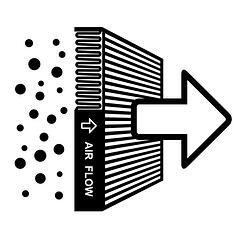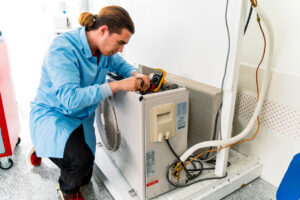Each year, many adults and kids alike are unintentionally poisoned in their own home. They may be poisoned by breathing in harmful substances such as carbon monoxide or by accidentally ingesting harmful substances.
In some cases, unintentional poisoning has resulted in serious injury that requires hospitalization, and some cases have resulted in permanent health issues or even in death.Identifying potential dangers in the home and taking steps to decrease the likelihood of unintentional poisoning can be beneficial to you and those who spend time in your home.
The Potential for Gas And Carbon Monoxide Poisoning
There are several different types of toxic gases that are commonly found in homes. Some gases, like natural gas that you may use for cooking at your stove or that may be used with a gas-powered fireplace, have a rather identifiable odor. Other gases, like carbon monoxide, or completely odorless, and you may not be aware of the presence of carbon monoxide in the home until it is too late.
Understanding the sources of these gases in the home and taking steps to prevent a leak or to identify the presence of dangerous levels of these gases can be beneficial and even life-saving in some cases.
Sources of Carbon Monoxide in the Home
Carbon monoxide can be difficult to detect in a home without a carbon monoxide alarm system installed. This is because the gas has no color, taste or smell. It is invisible and highly deadly. Even when death does not occur as a result of carbon monoxide poisoning, long-term health effects are possible.
Carbon monoxide may be present in the home from a number of sources. For example, it is produced when other substances like coal, oil, kerosene and others are not completely burned, and this may occur through faulty equipment or because of other related reasons.
Identifying Risks of Carbon Monoxide Poisoning
One of the most important steps that you can take to prevent carbon monoxide poisoning in your home is to first identify the potential risks. This involves identifying each gas-burning appliance in the home. These appliances may include stoves, ovens, dryers, furnaces, fireplaces and other items. Ideally, these appliances will be tested one time per year for leaks or other maintenance issues that may result in the production of carbon monoxide.
Homeowners should also be aware of warning signs that these appliances may not be functioning properly, and steps should be taken to repair them at the first sign of a repair issue. For example, a gas-burning stove may show signs of damage if the burner’s flame appears to be lazy and has a yellowish or orange tint. Ideally, the flame should have a bluish hue. When repair needs are identified, making the repairs should be a priority for the homeowner.
The Safe Use of Appliances
When you purchase a new appliance, it’s necessary to take the few minutes necessary to carefully read through the instructions and understand them. While the general use of many fuel-burning appliances may be self-explanatory, there are intricacies you must learn by taking the time to educate yourself. You can learn things such as what types of materials are acceptable for fuel to keep you and your family both warm and safe. Furthermore, the safety manual for these appliances and equipment will provide you with useful information for identifying specific warning signs for each item and for proper care to prevent a carbon monoxide issue.
If you have any type of fuel-burning equipment in your home, it’s crucial that it’s vented outside. From fireplaces to furnaces and more, this is an important measure to best ensure carbon monoxide is not introduced into the home.
The Safe Use of HVAC Equipment

It’s crucial to ensure you change your filters at least once every three months. Failure to do so can result in carbon monoxide buildup. Other contributors to this dangerous problem include inadequate air supply, operation of the furnace with the front panel door open or improperly closed, and cracks in the heat exchanger or other internal parts.
Even if you had your chimney recently inspected, it’s important to regularly check for hindrances. For example, a bird could decide to build it’s summer nest in your chimney, and this could cause a dangerous blockage that must be addressed.
Just as you put effort into ensuring your car is running efficiently, you should also put the same time and energy into your gas appliances and equipment. Over time, they are prone to problems just as any other mechanical device. Aside from proactive measures such as changing filters, you should also work directly with a professional HVAC technician to best ensure you aren’t overlooking any potentially dangerous issues.
When in doubt, it’s well worth the investment to have a professional inspect your unit. They will be able to offer individualized advice to help ensure you and your family are safe at all times. Furthermore, they can use their tools and experience to clean your unit to make sure there are no hindrances that can increase your chances of poisoning.
The Benefit of a Carbon Monoxide Alarm
Even when the best preventive steps are taken to minimize the risk of carbon monoxide from entering the home, the unfortunate truth is that carbon monoxide leaks can still occur. Occupants in the home could breathe in small but dangerous levels of carbon monoxide regularly over a lengthy period of time and suffer serious health effects, or the amount of carbon monoxide in the home could skyrocket quickly over a short period of time and result in almost immediate death.
A carbon monoxide alarm installed in the home can be a life-saving device because it can detect even trace amounts of carbon monoxide and can signal to the home’s occupants that the air in the home may be unsafe to breathe. A carbon monoxide alarm may be placed on both levels of the home, and it may be especially useful in areas where gas-powered appliances are in use, such as in the kitchen and laundry room.
Learning More About Carbon Monoxide

Because all homeowners and home occupants may be exposed to carbon monoxide at some point in time, it is important to understand what the symptoms of carbon monoxide poisoning are. Even if an alarm has been installed in the home, recognizing the symptoms of carbon monoxide poisoning can ultimately save lives.
Many of the symptoms of carbon monoxide poisoning mimic the flu, and some of these include nausea, headache, fatigue and dizziness. Individuals may also notice visual disturbances and difficulty concentrating. If multiple people in a house develop similar symptoms and if symptoms disappear when they leave the house for a period of time, this is a sign that carbon monoxide may be present in the home.
Individuals who believe that they have been exposed to carbon monoxide should initially step outside to breathe fresh air. Then, they should open all of the doors and windows to the home and ensure that all gas appliances have been turned off. The next step to take is to visit a doctor and to request maintenance service on gas appliances.
A Word About Other Types of Poisoning
Carbon monoxide poisoning can be very serious because it is a deadly substance that is often difficult to identify before it is too late. However, there are also other sources of poisoning that may affect individuals in a home.
Children may be most likely to be poisoned by other substances, and these include medications. All medications should be stored in a locked cabinet where children cannot access them. When they are in use, care should be taken to keep them out of the reach of kids, and kids should never be told that medication is or tastes like candy.
Even adults can become accidentally poisoned through the improper use medications. For example, when multiple medications or medication and alcohol are consumed together, the combination can be dangerous or lethal. Therefore, it is important for adults to read the safe handling and usage instructions of medications before using them.
Household Cleaners and Chemicals
In many homes, there are a number of household cleaning products and other chemical substances that must be handled with care. These substances include everything from hair care products and mouthwash to disinfectant cleaning products, pesticides, antifreeze and more. These substances may be stored in rooms of your home like the garage, the kitchen, the bathroom and the laundry room. While you may choose to store them in a location of the home that is convenient for you, you should ensure that they are placed inside a locked cabinet where children who live in or who visit your home cannot access them.
Even when they are being actively used, care should be taken to be vigilant about their use. Keep in mind that a child can easily walk up behind an adult who is cleaning, for example, and grab the bottle before the adult is aware.
Even adults who are using the products as intended can be unintentionally harmed by them. For example, when certain types of household cleaners are mixed together during a cleaning session, they can emit a poisonous gas.
Lead Poisoning
Another source of poisoning in the home relates to lead poisoning. Exposure to lead can be dangerous for all individuals because it can result in serious or even fatal damage to the kidneys, central nervous system and other vital organs. The substance is especially dangerous to young children and pregnant women.
One of the most common causes of lead poisoning is lead-based paint. Prior to 1978, lead was commonly used to make paint, so many homes that were constructed before this time had lead-based paint. Those who live in an older home built before 1978 should have their home tested for the presence of lead-based paint, and steps should be taken to remove it if it is present in the home.
Because exposure to this substance can be so dangerous to deal with, it is important to seek professional assistance to have it removed. Furthermore, children should be kept away from the area during the removal process. Visit here Nice Heating and Air for HVAC services.
 SEE OUR SPECIALS
SEE OUR SPECIALS SCHEDULE SERVICE
SCHEDULE SERVICE





 Call 703-884-2376
Call 703-884-2376


